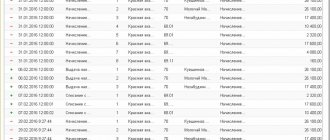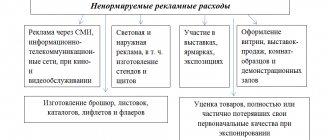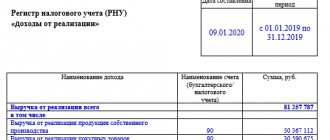In this article, Professor M.L. Pyatov continues to acquaint readers with the provisions of the new law “On Accounting” dated December 6, 2011 No. 402-FZ. The material is devoted to the procedure for compiling and presenting primary accounting documentation as the basis for accounting records and maintaining accounting registers, determined by the new Federal Law.
In the Federal Law of December 6, 2011 No. 402-FZ “On Accounting” (hereinafter referred to as the Law of 2011), as well as in the version of the Federal Law of November 21, 1996 No. 129-FZ (hereinafter referred to as the Law of 1996), issues related to the procedure compilation and presentation of primary accounting documents as the basis for entries in accounting accounts are determined by special article 9 “Primary accounting documents”. However, the provisions of the 2011 Law in this area contain significant innovations that should be noted.
Is it possible to have an account without a primary document?
Paragraph 1 of Article 9 of the 1996 Law established that “all business transactions carried out by an organization must be documented with supporting documents. These documents serve as primary accounting documents on the basis of which accounting is conducted.”
The provisions of the 2011 Law contain a slightly different wording: “every fact of economic life is subject to registration with a primary accounting document” (Clause 1, Article 9).
Does this mean that the primary document is no longer considered by the Law as the only “basis for accounting”? It is difficult to give a definite answer to this question. Formally, rather, yes, because the law states that “every fact of economic life” must be documented as a primary accounting document, and according to Article 5 of the 2011 Law, facts of economic life are not the only objects of accounting.
Registration of a fact of economic life that has not taken place
It should be noted: unfortunately, the new law does not contain an answer to the question of whether it is possible to hold accountable an accountant who recorded one fact of economic life instead of another (incorrectly classified the economic situation), for example, reflected the business trip of an employee who, in accordance with the procedure prescribed by law, is assigned a traveling nature works In our opinion, the question posed should be answered in the negative, but much will depend on the judicial interpretation of the above rule.
Unified forms of primary documents
Paragraph 2 of Article 9 of the 1996 Law established that “primary accounting documents are accepted for accounting if they are drawn up in the form contained in the albums of unified forms of primary accounting documentation.” As an exception to this general rule, there was a rule according to which “documents, the form of which is not provided for in these albums, must contain the following mandatory details: a) the name of the document; b) date of preparation of the document; c) the name of the organization on whose behalf the document was drawn up; d) content of the business transaction; e) measures of business transactions in physical and monetary terms; f) the names of the positions of the persons responsible for the execution of the business transaction and the correctness of its execution; g) personal signatures of these persons.” “In order to implement the provisions of the Federal Law “On Accounting” of 1996, the Government of the Russian Federation issued Resolution No. 835 dated 07/08/1997 “On Primary Accounting Documents” (hereinafter referred to as the Resolution), in which the State Committee of the Russian Federation on Statistics was assigned “the functions of development and approval of albums of unified forms of primary accounting documentation and their electronic versions” (clause 1 of the Resolution).
Also, the State Committee of the Russian Federation on Statistics was ordered to “ensure, through territorial statistical bodies, starting from January 1, 1998, the provision of albums of unified forms of primary accounting documentation and their electronic versions to users on a contractual basis, while observing the principle of competition” (clause 4 of the Resolution).
In pursuance of the Decree of the Government of the Russian Federation dated 07/08/1997 No. 835, the State Committee of the Russian Federation on Statistics and the Ministry of Finance of Russia issued a joint Resolution (respectively, dated 05/29/1998 No. 57a and dated 06/18/1998 No. 27n), which approved the Procedure for the phased introduction in organizations independently on the form of ownership of those operating on the territory of the Russian Federation, unified forms of primary accounting documentation (hereinafter referred to as the Procedure).
According to this Procedure, from January 1, 1999, primary accounting documents had to be accepted for accounting “if they are compiled according to unified forms approved by the State Statistics Committee of Russia in 1997-1998. in agreement with the Ministry of Finance of Russia, the Ministry of Economy of Russia and other interested federal executive authorities for the following sections of accounting: accounting for agricultural products and raw materials; on accounting of labor and its payment; on accounting of fixed assets and intangible assets; on materials accounting; on accounting for low-value and wear-and-tear items; on accounting of work in capital construction; on accounting for the operation of construction machines and mechanisms; on accounting of work in road transport; on recording inventory results; on accounting of cash transactions; on accounting of trade transactions". According to paragraph 5 of this Procedure, the provision of unified forms of primary accounting documentation and their electronic versions to users of albums was to be carried out by territorial bodies of state statistics, starting from January 1, 1998, on a contractual basis.
The 2011 law repeals this provision. Paragraph 2 of Article 9 only defines the mandatory details of primary documents. According to the Law, “the mandatory details of the primary accounting document are:
1) name of the document;
2) date of preparation of the document;
3) the name of the economic entity that compiled the document;
4) the content of the fact of economic life;
5) the value of the natural and (or) monetary measurement of a fact of economic life, indicating the units of measurement;
6) the name of the position of the person (persons) who completed the transaction, operation and who is responsible (responsible) for the correctness of its execution, or the name of the position of the person (persons) responsible for the accuracy of the execution of the event;
7) signatures of the persons provided for in paragraph 6 of this part, indicating their surnames and initials or other details necessary to identify these persons.”
The composition of the mandatory details of the primary document has been preserved, but here you should pay attention to the wording of the 2011 Law regarding the details reflecting the meter of the fact of economic life.
If the 1996 Law spoke about “measurements of a business transaction in physical and monetary terms,” then the 2011 Law indicates “the value of the natural and (or) monetary measurement of a fact of economic life, indicating the units of measurement.” Thus, according to the new Law of 2011, the primary document may not contain the monetary measurement of the business fact reflected in the accounting.
According to paragraph 4 of the 2011 Law, “the forms of primary accounting documents are approved by the head of the economic entity upon the recommendation of the official charged with maintaining accounting records. The forms of primary accounting documents for public sector organizations are established in accordance with the budget legislation of the Russian Federation.”
Accounting info
Primary documents received by the accounting department must be checked both in form (completeness and correctness of primary documents, filling in details) and in content (legality of documented transactions, logical linking of individual indicators).Then the registration and economic grouping of their data are carried out in a system of synthetic and analytical accounting accounts. For this purpose, information about the balances of property, economic assets and the sources of their formation, as well as data on business transactions from the relevant primary or consolidated documents are recorded in accounting registers.
Accounting registers are counting tables of a certain form, built in accordance with the economic grouping of data on property and the sources of its formation. Essentially, they are carriers of data on business transactions obtained from the relevant primary and summary documents.
Accounting registers are intended to systematize and accumulate information contained in primary documents accepted for accounting, for reflection on accounting accounts and in financial statements.
The set of accounting registers used in an organization to reflect business transactions in a certain sequence and grouping by appropriate methods of records form a form of accounting.
These forms are united by the unity of accounting principles: business transactions confirmed by primary documents are reflected in accounting registers, without any exception, by double entry in accounting accounts in accordance with the Chart of Accounts for accounting financial and economic activities of organizations, approved by the Order of the Ministry of Finance of the Russian Federation of October 31, 2000 . No. 94n.
In addition, accounting registers, regardless of what form of accounting they belong to, serve as an intermediary between primary accounting documents and the organization’s financial statements, allowing, as mentioned above, to reflect, summarize and systematize accounting information.
The forms of accounting used in Russian accounting practice are diverse. The choice of accounting form remains at the discretion of the head of the organization and the chief accountant, is enshrined in the order on accounting policy and is carried out depending on various conditions, primarily on the scale of the business and the degree of automation of accounting in the organization.
Small enterprises, for example, can use a simplified form of accounting proposed by the Order of the Ministry of Finance of the Russian Federation dated December 21, 1998. No. 64n, which can be maintained by:
✔ a simple form of accounting (without the use of accounting registers for the property of a small enterprise) - in the “journal-main” form;
✔ form of accounting using accounting registers for the property of a small enterprise.
For other economic entities, memorial-order and journal-order forms of accounting are provided.
A simple form of accounting is applicable to small enterprises that carry out a small number of business transactions (usually no more than thirty per month) and do not carry out production of products and work associated with large expenditures of material resources. In this case, accounting for all transactions is carried out by registering them only in the book (journal) for recording the facts of economic activity in Form No. K-1.
Along with the book for recording settlements for wages with employees and for income tax with the budget, a small enterprise must also maintain a payroll record sheet in Form No. B-8.
The book is a register of analytical and synthetic accounting, on the basis of which it is possible to determine the availability of property and funds, as well as their sources, in a small enterprise as of a certain date and to prepare financial statements. It is a combined accounting register that contains all the accounting accounts used by a small enterprise and allows you to keep track of business transactions on each of them. At the same time, the book must be sufficiently detailed to justify the content of the relevant balance sheet items.
The form of accounting using accounting registers for the property of a small enterprise is acceptable for small enterprises engaged in the production of products (works, services), and includes the following accounting registers:
Statement of accounting of fixed assets, accrued depreciation charges - form No. B-1;
Statement of accounting for inventories and goods, as well as VAT paid on valuables - form No. B-2;
Production cost accounting sheet - form No. B-3;
Statement of accounting of cash and funds - form No. B-4;
Statement of accounting of settlements and other transactions - form No. B-5;
Sales accounting sheet – form No. B-6 (payment);
Statement of accounting of settlements and other operations - form No. B-6 (shipment);
Statement of settlements with suppliers - form No. B-7;
Payroll record sheet – form No. B-8;
Sheet (chess) - form No. B-9.
Each statement, as a rule, is used to record transactions on one of the accounting accounts used.
The amount for any transaction is recorded simultaneously in two statements: in one - according to the debit of the account, indicating the number of the account being credited, in the other - according to the credit of the corresponding account and a similar entry in the number of the debited account. In both statements, an entry is made based on the forms of primary accounting documentation about the essence of the transaction performed or explanations, codes, etc.
Fund balances in separate statements must be verified with the corresponding data from the primary documents on the basis of which the entries were made (cash reports, bank statements, etc.).
A generalization of the monthly results of the financial and economic activities of a small enterprise, reflected in the statements, is made in a statement (chessboard) according to form No. B-9, on the basis of which the turnover statement is compiled. The turnover sheet is the basis for drawing up the balance sheet of a small enterprise.
All applicable statements indicate the month in which they are filled out, and, if necessary, the name of the synthetic accounts. At the end of the month, after calculating the total turnover, the statements are signed by the persons who made the accounting records in the small enterprise.
The document flow diagram within this form of accounting is as follows:
The memorial-order form of accounting seems more complex. It is used in several variants depending on industry characteristics and type of enterprise. It combines book and card development and grouping accounting registers. Synthetic accounting is kept in books or multigraph statements, and for analytical accounting books, statements and cards are used.
The documents verified and accepted for accounting are systematized according to the dates of transactions (in chronological order) and are issued with memorial orders - accumulative statements, which are assigned permanent numbers. For example, memorial order 1 – accumulative statement for cash transactions; memorial order 2 - a set of payroll statements, etc.
This makes it easier to find the necessary documents and prepare various certificates. The number of orders drawn up per month is determined by the chief accountant. The memorial order looks like this:
For operations that cannot be systematized and for “Storno” operations, separate memorial orders are drawn up, which are numbered for each month separately.
In organizations in which the volume of transactions does not require the preparation of cumulative statements, the correspondence of accounts is indicated on separate memorial orders or on stamp impressions affixed directly to the primary documents with the assignment of the corresponding numbers. The stamp must contain the same mandatory details as the memorial order: number, date of issue, correspondence of accounts, amount, signature of the responsible person - and a number of additional ones (if necessary).
Separate memorial orders are drawn up as transactions are carried out, but no later than the next day after receipt of the primary document, both on the basis of individual documents and on the basis of a group of similar documents. The correspondence of accounts in the memorial order is recorded depending on the nature of the transactions on the debit of one account and the credit of another account, or the debit of one account and the credit of several accounts, or, conversely, the credit of one account and the debit of several accounts.
Memorial orders are signed by the chief accountant or his deputy and the executor, and when accounting is centralized, by the head of the accounting group. Compiled memorial orders are recorded in chronological order in the registration journal.
Memorial order data is transferred to the general ledger, where each spread corresponds to a separate account. In this case, on the left side of the account data on business transactions are reflected on the debit side, and on the right side - on the credit of this account. The results of the debit and credit of the general ledger accounts are recorded in the turnover sheet, constructed using synthetic accounts, on the basis of which the balance sheet is compiled.
Thus, the document flow diagram for the memorial-order form of accounting is presented as follows:
The advantages of the memorial-order form of accounting are the simplicity and clarity of its accounting registers. At the same time, with predominantly manual filling of accounting registers, the volume of routine work on filling out memorial orders is extremely large.
As a result, a more advanced form of accounting was developed - a journal-order form of accounting.
This form of accounting is based on the principles of accumulating and systematizing data from primary documents in accounting registers, allowing for synthetic and analytical accounting of source funds and business transactions in all sections of accounting. This eliminates the need for memorial orders.
Chronological and systematic recording of business transactions is carried out simultaneously as a single workflow.
Entries in cumulative registers are made in the context of indicators necessary for managing the financial and economic activities of the enterprise, as well as for reporting purposes. Analytical and synthetic accounting is carried out, as a rule, in a single system of records. Two types of accounting registers are used here: order journals and auxiliary statements.
At the same time, enterprises can independently adapt the used accounting registers to the specifics of their activities, subject to the general methodological principles established by the Federal Law “On Accounting”. The list of standard registers of a single journal order form is as follows.
In addition to accounting registers, the following forms of development tables are recommended:
As an exception, for some types of accounts for which there is a significant number of personal accounts, analytical accounting cards can be created and, based on their data, turnover sheets can be compiled at the end of the month.
In addition, inventory cards or books of accounting for fixed assets are maintained, cards or sheets for accounting for production costs for calculated objects, as well as grading balance sheets for accounting for materials, grading (balance or turnover) sheets for accounting for finished products.
The main registers of this form of accounting are order journals. Auxiliary statements are usually used in cases where the necessary analytical indicators are difficult to obtain directly in order journals. Therefore, the data from primary documents is pre-grouped in statements, and their results are then transferred to order journals.
The total data of journal orders at the end of the month is transferred to the general ledger. Based on the general ledger data, a balance sheet is compiled. In cases where accounting balances need to be shown in the balance sheet for several items, the entry is made on the basis of accounting registers.
The general ledger is opened for a year and serves to summarize data from order journals, mutual verification of the correctness of entries made in individual accounts and to draw up a balance sheet. It records the balance at the beginning of the month, turnover in the debit and credit of accounts and the balance at the end of the year for each synthetic account.
In the general ledger, data on current turnover of property (funds) is recorded only according to synthetic accounts. The credit turnover of each synthetic account is reflected in one entry, and the debit turnover is reflected in correspondence with the accounts being credited. Checking the correctness of the entries made in the general ledger is carried out by calculating the amounts of turnover and balances for all accounting accounts.
The amounts of debit and credit turnovers, as well as the amounts of debit and credit balances must be equal, respectively.
When using the journal-order form of accounting, there is no need to draw up a checklist and a checkerboard balance sheet, as well as a balance of turnover on accounts.
The general flow of documents within the journal-order form of accounting is shown in Diagram 1.3.
Entry into accounting registers is carried out manually or using a computer.
With the manual method, transactions are recorded manually with ink or a ballpoint pen (if it is necessary to have several copies, by copying). With the computer method, recording is made using computer accounting programs.
Correction of errors in accounting registers is carried out using the corrective method, the method of additional postings and the “red reversal” method.
The corrective method is used if the error made in the accounting register does not affect the correspondence of accounts or it is quickly detected and does not affect the accounting results.
The essence of the proofreading method is that the erroneous text or amount is crossed out and the correct text or amount is written above the crossed out (or under the crossed out - depending on the available options).
Crossing out is done with a thin line so that what has been crossed out can be read. In this case, the entire number is crossed out, even if an error is made in only one digit.
Correction of an error is specified and confirmed: in documents - by the signatures of the persons who signed the document, in accounting registers - by the signature of the person making the correction. A correction clause is made in the margins or at the end of the page, writing there “Believe the corrected” and the correct text or amount.
In accounting practice, the expression “write in red” or “reversal” is often encountered. This means that a reversal entry has been made (that is, the numbers written in this way are taken into account when calculating with a minus sign).
The regulatory documents do not define the procedure for making “reversal” entries.
In practice, two common variants of this notation are used:
1) the reversal entry is made in red ink or paste;
2) the number to be reversed is written in paste or ink of the same color as the other entries, and then surrounded by a solid line.
After registering a business transaction in the accounting register, an appropriate mark is made on the accounting entry or on the primary document itself to facilitate subsequent verification of the correctness of the posting.
At the end of the month, results are summed up on each page of the accounting registers. The final records of synthetic and analytical registers must be reconciled by compiling turnover sheets or in another way.
Turnover statements are a way of summarizing accounting registration data in accounting accounts. Turnover statements are compiled at the end of the month based on the following data:
• balance (remainder) at the beginning of the month;
• monthly turnover;
• balance at the end of the month.
Turnover statements can be compiled according to synthetic and analytical accounting accounts.
Example. The accountant calculated the wages of the organization's employees and prepared a pay slip. The accountant calculates wages on the basis of the working time sheet and documents that establish the wages of employees and additional payments (employment contracts, orders, staffing). The payroll is an accounting register. For May it looks like this (balance account numbers are indicated in brackets):
Based on the payroll sheet, we will draw up a turnover sheet for balance sheet account 70 “Settlements with personnel for wages” for May:
Thus, the final balance is 4178 rubles. (5000 + 5500 – 6322), which we received in the payroll sheet, coincided with the final balance received in the turnover sheet. Now let’s present business transactions for the calculation and payment of wages for May in the form of accounting entries: Debit 44 Credit 70– 5500 rub. – wages for May were accrued (at the same time, sales expenses were increased); Debit 70 Credit 68–572 rub. – personal income tax is withheld from accrued wages; Debit 70 Credit 76–750 rub. – alimony is withheld from wages; Debit 70 Credit 50–5000 rub. – wages for the previous month were issued from the organization’s cash desk (the organization’s wage debt to employees as of April 30).
A turnover analytical sheet can be compiled at any level of analytical accounting.
Example. It is necessary to find out the status of the trade organization’s settlements with the supplier Fakel LLC at the end of February under all existing contracts. Then we need a turnover sheet for account 60-1-1-01:
We have compiled an analytical statement in expanded form. If we need generalized information, then the same statement will look like this:
If accounting is carried out using a computer method, then the accountant enters entries in exactly this structure. With the manual method of accounting, the accountant makes postings in journals (statements) according to synthetic accounts and subaccounts, and makes analytical entries in cards.
The turnover balance sheet (turnover balance sheet) is compiled at the end of the month based on data for each synthetic account: balances at the beginning of the month (opening or opening balance), turnover for the month and balances at the end of the month (closing balance). The balance sheet can be compiled only using synthetic accounts or in the context of subaccounts.
The statements record all synthetic accounts used at the enterprise. Each account is assigned a separate line, which indicates the opening balance, debit and credit turnover and the ending balance. If there was no movement in the account during the reporting period, then only the opening and closing balances are indicated. To check whether the balance sheet is drawn up correctly, you should know the following rules:
• the total of debit opening balances on accounts must equal the total of credit opening balances;
• the total of debit turnover for the period must be equal to the total of credit turnover;
• the total of debit ending balances on accounts must equal the total of ending credit balances.
Data from the balance sheet on account balances are used in drawing up the balance sheet.
Example: The trading organization Vostok LLC, as of March 31, has the following indicators (synthetic account numbers are indicated in brackets): – fixed assets (01) – 500,000 rubles; – depreciation on these fixed assets (02) – 100,000 rubles .;– goods (41) – 300,000 rubles;– money in the cash register (50) – 20,000 rubles;– money in the current account (51) – 115,000 rubles;– debt to suppliers of goods (60) – 175 000 rub.; – bank loan (66) – 300,000 rub.; – debt to employees for wages (70) – 90,000 rub.; – authorized capital (80) – 200,000 rub.; – retained earnings (84 ) - 70,000 rubles. Business transactions in April were reflected in the accounting records with the following entries:
To simplify the example, the entries are compiled in such a way that each account is involved in transactions once in debit and once in credit, except for accounts 51 and 90. Therefore, the turnover sheet, the data from which is taken for the balance sheet, is compiled only for these synthetic accounts.
And finally, we draw up the balance sheet for April:
Comments:
- In contact with
Download SocComments v1.3
| Next > |
Primary document carriers
Let us recall that paragraph 7 of Article 9 of the 1996 Law determined the provision according to which “primary and consolidated accounting documents can be compiled on paper and computer media. In the latter case, the organization is obliged to produce, at its own expense, copies of such documents on paper for other participants in business transactions, as well as at the request of the authorities exercising control in accordance with the legislation of the Russian Federation, the court and the prosecutor’s office.” This requirement of the Law has changed both in form and content, in particular with the introduction of the requirement for an electronic signature.
According to paragraph 5 of Article 9 of the 2011 Law: “The primary accounting document is drawn up on paper and (or) in the form of an electronic document signed with an electronic signature.” At the same time, paragraph 6 of Article 9 of the 2011 Law establishes that “if the legislation of the Russian Federation or an agreement provides for the submission of a primary accounting document to another person or to a government body on paper, the economic entity is obliged, at the request of another person or government body, at its own expense make hard copies of the primary accounting document compiled in the form of an electronic document.” Here the reader’s attention should be drawn to the existence of a special Federal Law dated 04/06/2011 No. 63-FZ “On Electronic Signatures”, Article 2 of which defines an electronic signature as “information in electronic form that is attached to other information in electronic form (signed information) or is otherwise associated with such information and which is used for the specific person signing the information.”
This Law “regulates relations in the field of the use of electronic signatures when making civil transactions... when performing other legally significant actions” (Article 1) and, in particular, defines:
- the procedure for legal regulation of relations in the field of using electronic signatures;
- principles of using an electronic signature;
- types of electronic signatures;
- conditions for recognizing electronic documents signed with an electronic signature as equivalent to paper documents, etc.
Corrections in primary documents
The 1996 Law, while defining the procedure for corrections in primary documents, actually contained provisions related to other areas of legislation (regulation of banking activities, etc.).
Let us recall that paragraph 5 of Article 9 of the 1996 Law established that “corrections to cash and banking documents are not allowed. Corrections can be made to other primary accounting documents only by agreement with the participants in business transactions, which must be confirmed by the signatures of the same persons who signed the documents, indicating the date of the corrections.” According to paragraph 7 of Article 9 of the 2011 Law, “corrections are allowed in the primary accounting document, unless otherwise established by federal laws or regulations of state accounting regulatory bodies. The correction... must contain the date of the correction, as well as the signatures of the persons who compiled the document... indicating their surnames and initials or other details necessary to identify these persons.”
Nuances of making edits
The person maintaining the accounting records of an enterprise is directly responsible for reporting false information, concealing data and distorting it. Two points simultaneously follow from this: on the one hand, the desire to correct a document should be encouraged, on the other hand, it should be punished, since this introduces confusion into control over the organization.
Therefore, correction of errors is allowed, but only if the rules are followed. If at least one of them is violated, and the form is sent along with other documents to the Federal Tax Service or other authorities, the organization will be subject to penalties.
- The first method: you can cross out the erroneous information with one straight line, and write the correct information on top, above the erroneous information. Changes must be certified here with the signature of the person responsible for the company’s accounting;
- The second method, the so-called “reversal method”: without crossing out anything, you need to write an additional entry in red ink in the window where the error was made. In this case, the changes made must also be certified by a signature;
- Next to the correction you should indicate the date the changes were made;
- When correcting, use correctors, erasers, a blade, etc. It is highly not recommended: government authorities, when reading the document, should see the originally written data;
- In addition to all of the above, a brief and meaningful explanation of such corrections must be entered in the register where the error was made. For example: “When filling out the document, data on business income was mixed up with data on business expenses for the last quarter.”
Seizure of primary documents
The provisions of the Law on the possible seizure of primary accounting documents have also become more consistent with the framework of accounting legislation, without repeating the norms of tax, administrative, criminal and other areas of law.
Paragraph 8 of Article 9 of the 1996 Law established that “primary accounting documents can be seized only by the bodies of inquiry, preliminary investigation and prosecutor’s office, courts, tax inspectorates and internal affairs bodies on the basis of their decisions in accordance with the legislation of the Russian Federation,” and the “chief accountant or another official of the organization has the right, with the permission and in the presence of representatives of the authorities conducting the seizure of documents, to make copies of them indicating the reason and date of seizure.”
The 2011 law on this matter states the following: “If, in accordance with the legislation of the Russian Federation, primary accounting documents, including in the form of an electronic document, are seized, copies of the seized documents, made in the manner established by the legislation of the Russian Federation, are included in the documents accounting".
Storage order
Accounting documents must be stored in a specially designated room on shelves or in cabinets. Storage periods are stated in two main legal acts:
- Article 29 “On Accounting” - storage for periods established in accordance with the rules for organizing state archival affairs, but not less than 5 years after the reporting year.
- In paragraphs 8 clause 1 of Article 23 of the Tax Code of the Russian Federation - taxpayers are required to ensure the safety of accounting and tax accounting data and other data necessary for the calculation and payment of taxes, including accounting registers confirming the receipt of income, expenses, and payment (withholding) taxes, unless otherwise provided by the Tax Code of the Russian Federation.
In this case, the period of 4 years established by the Tax Code of the Russian Federation begins after the reporting (tax) period in which the documentation was last used to prepare tax reports, calculate and pay taxes, confirm income received and expenses incurred. In addition, a longer retention period may be established for certain types of registers. For example, payroll records must be kept for 75 years.
Therefore, the organization is obliged to ensure the safety of some registers throughout the entire period of activity, and then transfer them to the archive for storage.
Sample forms of accounting registers - 2021 can be downloaded below.
Procedure for maintaining accounting registers
The 2011 Law, in terms of the rules relating to the preparation and presentation of primary documents, contains, like the 1996 Law, a special article 10 “Accounting registers”. Clauses 1 and 2 of Article 10 of the 2011 Law reproduce the classic rules for organizing the system of accounting registers, according to which “data contained in primary accounting documents are subject to timely registration and accumulation in accounting registers” (clause 1), and “omissions or withdrawals when registering accounting items in accounting registers” (clause 2). The further provisions of section 10 of the 2011 Law contain significant changes that should be noted.
What might inspectors consider a gross violation of accounting and reporting requirements?
Author: N. Fimina
Federal Law No. 77-FZ dated March 30, 2016 amended the norms of the Code of Administrative Offenses of the Russian Federation concerning violations of accounting requirements.
Federal Law No. 77-FZ of March 30, 2016 (hereinafter referred to as Law No. 77-FZ) amended the norms of the Code of Administrative Offenses of the Russian Federation. These changes should be familiarized mainly to accountants of organizations and institutions, since they are related to the establishment of criteria for accounting and reporting.
Law No. 77-FZ came into force on April 10, 2021. In the new edition of Art. 15.11 of the Code of Administrative Offenses of the Russian Federation states that gross violation of accounting requirements, including accounting (financial) reporting, entails the imposition of an administrative fine on officials in the amount of 5,000 - 10,000 rubles. Repeated commission of this administrative offense entails the imposition of an administrative fine in the amount of 10,000 - 20,000 rubles. or disqualification for a period of one to two years.
At the same time, a gross violation of accounting requirements, including accounting (financial) reporting, means:
- understatement of taxes and fees by at least 10% due to distortion of accounting data;
- distortion of any indicator of accounting (financial) statements expressed in monetary terms by at least 10%;
- registration of a fact of economic life that has not taken place or an imaginary or feigned object of accounting in the accounting registers;
- maintaining accounting accounts outside the applicable accounting registers;
- preparation of accounting (financial) statements not based on data contained in accounting registers;
- the economic entity lacks primary accounting documents, and (or) accounting registers, and (or) accounting (financial) statements, and (or) an audit report on the accounting (financial) statements (if the audit of the accounting (financial) statements is mandatory) during the established storage periods for such documents.
Compared to the previous edition in Art. 15.11 of the Code of Administrative Offenses of the Russian Federation, the following changes are observed. Firstly, the size of the fine for gross violation of accounting and reporting requirements has been increased. Previously, a fine of 2,000–3,000 rubles was provided. Secondly, the content of the concept of gross violation of accounting requirements has been expanded. Now it includes, among other things, the registration of a fact of economic life that has not taken place or an imaginary or feigned object of accounting in accounting registers, maintaining accounting accounts outside the applicable accounting registers, as well as drawing up accounting (financial) statements not based on the data contained in the accounting registers. accounting, and the absence of primary accounting documents within the established storage periods of these documents.
Double entry accounting
First of all, it is the provisions of the new law on the procedure for organizing the system of accounting registers that now contain an indication that organizations must maintain accounting records using the double entry method.
In the 1996 Law, this instruction contained paragraph 4 of Article 8, which established that “the organization maintains accounting records of property, liabilities and business transactions by double entry on interrelated accounting accounts included in the working chart of accounts.”
Paragraph 3 of Article 10 of the 2011 Law determines that “accounting is carried out through double entry in the accounting accounts, unless otherwise established by federal standards.” This is not only a change in the place of this rule in the text of the Law, but also the introduction into it of the possibility of defining exceptions for this rule by federal accounting standards.
However, the change in the position of this norm in the structure of the Law is also important, since its placement in Article 10 emphasizes the role of accounting accounts as a grouping feature that organizes the system of accounting registers.
Introduction
So we got to the accounting registers of the 1C:Enterprise 8.x platform. Previously, we talked about accumulation registers and information registers , examined in detail their structure and the principle of working with them from the platform.
In this regard, accounting registers are more interesting and complex, because have a larger number of settings, and the very specifics of accounting complicate their storage structure in the database, as well as the SQL queries of the platform to obtain this data. In this series of articles we will look at general information about the accounting register, its storage structure in the database depending on the settings, the construction of SQL queries of the platform when using various virtual tables, the influence of the chart of accounts on the register settings, as well as other features related to totals and other points.
In the first part, which is now open to you, we will look at the internal structure of the accounting register with a frequently used structure.
So let's get started!
Mandatory details of accounting registers
Paragraph 2 of Article 10 of the 1996 Law established that “business transactions must be reflected in the accounting registers in chronological order and grouped into the appropriate accounting accounts.” The 2011 Law abolishes the chronological sequence as the only possible option for organizing records in accounts, as indicated by one of the mandatory details of accounting registers defined by the Law - a norm that appeared in the Law for the first time.
According to paragraph 4 of Article 10 of the 2011 Law, “the mandatory details of the accounting register are:
1) name of the register;
2) the name of the economic entity that compiled the register;
3) the start and end date of maintaining the register and (or) the period for which the register was compiled;
4) chronological and (or) systematic grouping of accounting objects;
5) the monetary measurement of accounting objects indicating the unit of measurement;
6) names of positions of persons responsible for maintaining the register;
7) signatures of the persons responsible for maintaining the register, indicating their surnames and initials or other details necessary to identify these persons.”
By analogy with the definitions regarding primary documents, paragraph 5 of Article 10 of the Law establishes that “the forms of accounting registers are approved by the head of an economic entity upon the recommendation of the official charged with maintaining accounting records. Forms of accounting registers for public sector organizations are established in accordance with the budget legislation of the Russian Federation.”
What it is
Using registers, the accountant records the receipt and consumption of goods, payment orders, registers new items of goods/services, their name and much more.
At the same time, accumulation occurs - an expense reflected using accounting entries.
Primary documents are the basis for drawing up annual financial statements and filling out tax returns for profits and VAT.
Accounting services Voronezh from the company - cbius.khimenko-vrn.ru
Accounting registers and trade secrets
The 1996 Law contained a special rule indicating the following: “The contents of accounting registers and internal accounting reports are a trade secret” (clause 4 of article 10).
The 2011 law does not contain this provision, which naturally raises the question of maintaining the status of a trade secret of an economic entity for the contents of accounting registers.
Here, as in the cases of correction of legal provisions discussed above regarding the removal of irrational repetitions from normative legal acts of other areas of current law, we should use the general provisions of the Federal Law of July 29, 2004 No. 98-FZ “On Trade Secrets” (hereinafter referred to as the Law “ About trade secrets").
Article 3 of this Law defines a trade secret as “a regime of confidentiality of information that allows its owner, under existing or possible circumstances, to increase income, avoid unjustified expenses, maintain a position in the market for goods, works, services, or obtain other commercial benefits.”
At the same time, the Law establishes that information constituting a trade secret (trade secret) is “information of any nature (production, technical, economic, organizational and others), including the results of intellectual activity in the scientific and technical field, as well as information about methods of carrying out professional activities that have actual or potential commercial value due to their unknownness to third parties, to which third parties do not have free access legally and in respect of which the owner of such information has introduced a trade secret regime.”
The Law also specifically defines the concepts of the owner of information constituting a trade secret, access to such information, its transfer and provision, and disclosure of information of this type.
According to Article 3 of the Law “On Trade Secrets”:
“the owner of information constituting a trade secret is a person who legally possesses information constituting a trade secret, has limited access to this information and has established a trade secret regime in relation to it;
access to information constituting a trade secret - familiarization of certain persons with information constituting a trade secret, with the consent of its owner or on another legal basis, subject to maintaining the confidentiality of this information;
transfer of information constituting a trade secret - transfer of information constituting a trade secret and recorded on a tangible medium, by its owner to the counterparty on the basis of an agreement to the extent and on the terms provided for by the agreement, including the condition that the counterparty takes measures established by the agreement to protect its confidentiality;
provision of information constituting a trade secret - the transfer of information constituting a trade secret and recorded on a tangible medium by its owner to government bodies, other government bodies, local government bodies in order to perform their functions;
disclosure of information constituting a trade secret - an action or inaction as a result of which information constituting a trade secret, in any possible form (oral, written, other form, including using technical means), becomes known to third parties without the consent of the owner of such information or contrary to an employment or civil law contract.”
According to Article 5 of the Law “On Trade Secrets”, “a trade secret regime cannot be established by persons engaged in business activities in relation to... information... the mandatory disclosure of which or the inadmissibility of restricting access to which is established by other federal laws.”
Paragraph 11 of Article 13 of the 2011 Law determines that “a trade secret regime cannot be established in relation to accounting (financial) statements.” In this case, the composition of the accounting (financial) statements is established by Article 14 of the 2011 Law, according to which “the annual accounting (financial) statements, except for the cases established by this Federal Law, consist of a balance sheet, a statement of financial results and appendices thereto” (p. . 1). “The annual accounting (financial) statements of a non-profit organization, with the exception of cases established by this Federal Law and other federal laws, consist of a balance sheet, a report on the intended use of funds and appendices thereto” (clause 2). “The composition of interim accounting (financial) statements, with the exception of cases established by this Federal Law, is established by federal standards” (clause 3). “The composition of the accounting (financial) statements of public sector organizations is established in accordance with the budget legislation of the Russian Federation” (clause 4). “The composition of the accounting (financial) statements of the Central Bank of the Russian Federation is established by Federal Law of July 10, 2002 No. 86-FZ “On the Central Bank of the Russian Federation (Bank of Russia)” (clause 5).
Thus, in accordance with the Law “On Trade Secrets”, an organization can establish a trade secret regime in relation to the contents of its accounting registers.
Carriers of accounting registers
The provisions of the Law regarding the media of accounting registers have also undergone certain changes.
Let us recall that the 1996 Law established that “accounting registers are maintained in special books (magazines), on separate sheets and cards, in the form of machine diagrams obtained using computer technology, as well as on magnetic tapes, disks, floppy disks and other computer media "(Clause 1, Article 10).
In accordance with Article 10 of the 2011 Law, “the accounting register is compiled on paper and (or) in the form of an electronic document signed with an electronic signature” (clause 6). “If the legislation of the Russian Federation or an agreement provides for the presentation of the accounting register to another person or to a state body on paper, an economic entity is obliged, at the request of another person or government body, to make at its own expense on paper copies of the accounting register compiled in the form electronic document" (clause 7).
It is obvious that this change in the text of the Law only brought the latter into greater compliance with the realities of our time.
What form do registers have?
They are divided not only by appearance, but also by form of construction.
The form of construction is:
- Single-sided or double-sided. The data is filled in the journal according to the selected form (the most common is a two-sided form);
- Chess. In this case, the data is divided according to some criterion - for example, the assets and liabilities of the organization - and filled in cells at an angle to each other. As a rule, existing debits and credits are taken as separating data. Debits are plotted horizontally in the journal, and credits are plotted vertically.
In addition to the construction form, each register has a document specialized for its use. This is called the external form of the register.
- All kinds of cards. The accountant fills out certain data on a special form with a table. As of 2021, it is possible to separate account, multi-column and inventory cards - for example, a card for analytical accounting of enterprise expenses;
- Books. They look like graphed and stitched registers, usually numbering more than two hundred papers. Each page of the book is numbered and signed by the chief accountant. The most famous books in this area are the general ledger of the organization, the ledger for accounting of fixed assets, the cash book, and the registration journal;
- The so-called “free sheets”. Enlarged cards, whose functionality differs little from simple forms - a free sheet only gives a little more insight into the state of the company. Various statements are often printed on blank sheets;
- Machinegrams. The same as stated above. The difference is that these documents are compiled or printed using computers. At the moment, the number of documents filled out using technology is growing at such a rapid pace that machinograms can be approved by the Government of the Russian Federation as an outdated type of registers.








